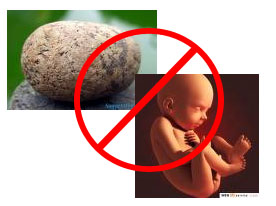The Theory of Evolution:
What’s wrong with this Picture?
I found it interesting in my research that the Catholic Church has accepted the theory of evolution, but that does not mean that there is not an intelligent designer involved. In October of 1996, Pope John Paul II issued a message to the Pontifical Academy of Science reaffirming the Roman Catholic Church’s long-standing position on evolution: that it does NOT necessarily conflict with Christianity.
Does evolution deny the existence of God? No.
There is no reason to believe that God was not a guiding force behind evolution. While it does contradict some specific interpretations of God, especially ones requiring a literal interpretation of Genesis 1, few people have this narrow of a view of God.
This is what people are talking about when they say that Evolution does not explain the whole picture.
Since Charles Darwin first published his book, The Origin of the Species, on November 24, 1859, more than a century has passed accounting for the existing body of data and testing the evidence against the theory of evolution. However, there are gaps and there are problems with the completeness of this record. The trail has been cold for some time and all the evidence cannot be found. There are unsolved puzzles.
There are major parts of the theory of evolution that I really have no problem accepting. What I do have a problem with, is the explanation for the force that is driving this change.
Missing Links in Fossils
The first big problem with evolution is that the fossil record increasingly does not, support it, a fact that famous Prof Steven Jay Gould of Harvard has described as “the trade secret of paleontology.” Evolutionary theory claims that there once existed a whole series of successive forms of the various organisms alive today. These changed by infinitesimal amounts with each generation as they evolved into the present varieties, so the fossil record should show these gradual changes. But it doesn’t. Instead, it shows the sudden emergence of new species out of nowhere, fully complete with all their characteristics and not changing over time. It is entirely devoid of forms that can be identified as intermediates between older and newer ones. This is popularly known as the “missing link’ problem, and it is massively systematic across different species and time periods. Worse, this problem is getting worse, not better, as more fossils are discovered, as the new fossils just resemble those already found and don’t fill in the gaps. In Darwin’s day, it was easy to claim that the fossils were there but had not been discovered. The problem is, we now have hundreds of thousands of well-cataloged fossils, from all continents and geologic eras, and we still haven’t found these intermediate forms.
No evidence that life emerged from dead matter 
Another problem with evolution is that it has only gotten worse with increasing biological knowledge is the question of how life initially emerged from dead matter. As recently as the early ’50s, it was still possible to hypothesize that discoveries would reveal the existence of entities intermediate between single-celled organisms and complex lifeless molecules. The existence of these intermediates (certain kinds of viruses were candidates for the role) would imply the possibility of an evolutionary transition from dead chemicals to intermediates to life. Unfortunately, the discovery of DNA in 1953 killed this hypothesis in its simplest form, and subsequent discoveries have only made the matter worse, Vast numbers of microorganisms are now known, as are vast numbers of complex molecules, but nothing in between. Furthermore, even the simplest possible cell imaginable within the limits of biology, let alone the simplest existing cell, is far too complex to have been thrown together by any known non-living chemical event. So even if evolution has an explanation of how species evolve from one to another, it has no way to “get the ball rolling” by producing the first species from something that is not a species.
The lack of “evolution” for humans
These results are contrary to what would be expected for the gradual evolutionary transformation of archaic Homo sapiens species into modern humans. If an evolutionary mechanism was responsible for modern man’s appearance, then evidence of gradual transformations should be observed in the archeological record. We simply do not see this. In the words of paleoanthropologist Christopher Stringer, “It is an extraordinary catalog of achievements that seem to have come from virtually nowhere.”  As biologists studied humans and species of apes in the 1970s and 1980s, some surprising information was being discovered that distinguished modern man from apes and other primates. Surprisingly, scientists discovered that human genetic diversity is far less than what one would predict from Darwinian theory. The genetic variation among the different human races has been found to be much less than that for isolated populations of chimps, orangutans, and other primate species. In addition, an analysis of the genetics of populations of apes reveals that different population groups possess fixed novel mutations that characterize each population. In contrast, there are no novel mutations or genetic alleles that specifically characterize any one human race from another. Dr. Maryellen Ruvolo (Harvard University) has noted, it’s a mystery none of us can explain.” Moreover, an examination of the genetic sequences of diverse modern human populations reveals minor differences, all this evidence suggested a recent origin for modern humans.
As biologists studied humans and species of apes in the 1970s and 1980s, some surprising information was being discovered that distinguished modern man from apes and other primates. Surprisingly, scientists discovered that human genetic diversity is far less than what one would predict from Darwinian theory. The genetic variation among the different human races has been found to be much less than that for isolated populations of chimps, orangutans, and other primate species. In addition, an analysis of the genetics of populations of apes reveals that different population groups possess fixed novel mutations that characterize each population. In contrast, there are no novel mutations or genetic alleles that specifically characterize any one human race from another. Dr. Maryellen Ruvolo (Harvard University) has noted, it’s a mystery none of us can explain.” Moreover, an examination of the genetic sequences of diverse modern human populations reveals minor differences, all this evidence suggested a recent origin for modern humans.
To add even more weight to the finding, scientists have also analyzed DNA from an ancient modern human skeleton. A British team analyzed a portion of DNA in a 10,000-year-old human skeleton found near Cheddar, England.116 The DNA from this skeleton differed from that of modern Europeans by only one nucleotide base pair essentially identical to that of modern humans, the lack of “evolution’ for humans over the last 10,000 years stands in sharp contrast to the differences seen between modern humans and Neanderthals.




.jpg)

You must log in to post a comment.